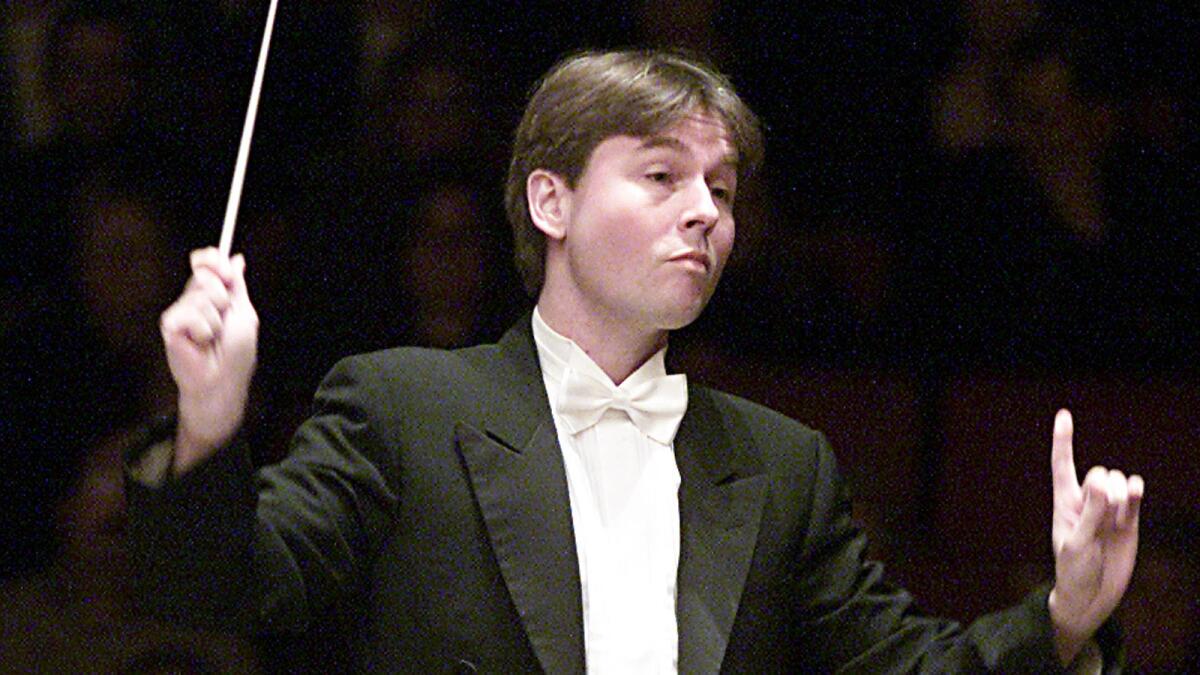From the Archives: An Inspired Opening for Esa-Pekka Salonen

- Share via
Lights. Camera. Mahler.
It is official at last. Esa-Pekka Salonen has become the 10th music-director of the Los Angeles Philharmonic Orchestra. Or the 11th, if one cares to count the lamented, aborted regime of Georg Solti.
It certainly didn’t look like business as usual Thursday night at the Music Center. A huge banner hailing the new chief adorned the facade of the Dorothy Chandler Pavilion. Patrons were handed flowers upon entering the sacred portals. Massive bouquets lined the stage apron.
FULL COVERAGE: Inside the L.A. Philharmonic
The Philharmonic made an unaccustomed semi-regimental entrance, which elicited halfhearted applause from the surprised audience. The gentlemen of the orchestra sported their spiffy new work uniform: white tie and tails.
In addition to the regular program magazine, which contained a lengthy interview with the new maestro, the management provided a fancy souvenir program that contained another lengthy interview with the new maestro. Both publications brimmed with glamorous photos of the resident boy wonder, and both offered a lot of administrative propaganda (including some revisionist suggestions of total triumph at the recent Salzburg Festival).
The subscribers roared their welcome when Salonen—eminently dapper and dashing—made his way to the podium. Some clapped stubbornly between movements, even though the conductor offered neither acknowledgment nor encouragement. When the final orgiastic cadence subsided, the crowd of 3,000 mustered an instant standing ovation.
Luckily, the standing ovation was justified. This concert didn’t sound like business as usual.
In an obviously sentimental gesture, Salonen programmed the formidable Third Symphony of Gustav Mahler. The same vehicle had inaugurated his international career rather sensationally when, at the tender age of 24, he blithely took over the baton from an ailing Michael Tilson Thomas with the Philharmonia of London in 1983.
His success on that fateful occasion led directly to his first American engagement—in Los Angeles the next year. The rest, as Nietzsche or Schopenhauer should have said, is history.
Salonen conducts this symphony as if he had written it. He understands the episodic structure, and he savors the conflicting tensions. It may, or may not, be coincidental that he, like Mahler, happens to be a composer, and that he is now about the age that Mahler was when the Third was conceived.
Salonen knows exactly how to contain the inherent sprawl. He knows how to gauge the thunderous climaxes, how to integrate the introspective bliss with the zonking violence. He knows how to brush past the marching-band vulgarity, how to focus the folksy charms, how to focus the exquisite lyricism and how to rattle (no pun intended) the Romantic rooftops.
Most important, perhaps, he knows how to keep the various elements of the symphony in proportion. He favors reasonable propulsion, even when Mahler preaches moderate restraint (“Ohne Hast”). But when he reaches the resolution of the final, otherworldly adagio, he dares to move very slowly. And yet he never seems to drag the tempo, never seems to exaggerate the emotional appeal.
Other conductors survey this sonic panorama effectively in 90 minutes. It took Salonen 10 minutes more than that on this poignant occasion. Still, he made the symphony seem short.
The Philharmonic played with rare cohesion and passion, with suavity (silken strings) and vigor (soaring brass) that would disarm even the nastiest Austrian critic. This, obviously, was a night for inspiration.
Birgitta Svenden, the Swedish mezzo-soprano, sang the “Zarathustra” solo with shining tone and muted pathos. The women of the Los Angeles Master Chorale (trained by Paul Salamunovich) and the Los Angeles Children’s Chorus (trained by Rebecca Thompson) defined the angelic piety of the “Wunderhorn” movement with sweetness and eager naivete.
A slip in the program announced that the concert was dedicated to the memory of Roger Wagner, a longtime Philharmonic collaborator and pioneering champion of choral music in this city.
More to Read
The biggest entertainment stories
Get our big stories about Hollywood, film, television, music, arts, culture and more right in your inbox as soon as they publish.
You may occasionally receive promotional content from the Los Angeles Times.










